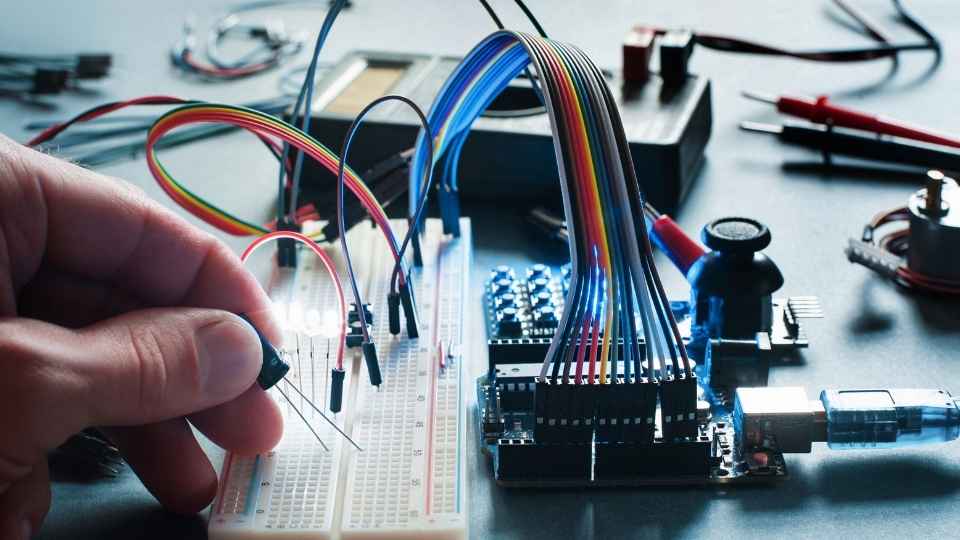
In the ever-evolving landscape of power supply technology, one concept stands out as a game changer: variable voltage. Like a conductor guiding an orchestra, variable voltage has the potential to revolutionize electrical systems by providing precise control and adaptability.
Imagine a symphony where each instrument can be fine-tuned to deliver its optimal performance. This article will decode the significance of variable voltage in power supplies, exploring its benefits and how it empowers innovation in this critical field.
Prepare to uncover the untapped potential of variable voltage and the exciting possibilities it holds for enhancing power supply efficiency.
Key Takeaways
- Variable voltage in power supplies allows for flexibility and adaptability in meeting the energy needs of different devices and applications.
- It enables users to power various devices with a single power supply, eliminating the need for multiple adapters or converters.
- Variable voltage enhances energy efficiency by matching power supply output with device specifications, optimizing performance and extending the lifespan of electronic devices.
- The implementation and integration of variable voltage in power supplies require a comprehensive understanding of its capabilities and careful integration into existing infrastructure, but it brings enhanced performance and efficiency in electrical systems when strategically implemented.
The Importance of Variable Voltage in Power Supplies
Variable voltage is a critical feature in power supplies as it allows for greater flexibility and adaptability in meeting the diverse energy needs of different devices and applications. By providing the ability to adjust the output voltage, power supplies can cater to a wide range of electronic components that require specific voltage levels for optimal performance. This feature enables users to power various devices with a single power supply, eliminating the need for multiple adapters or converters.
Moreover, variable voltage facilitates experimentation and customization in electronics projects. It empowers designers and engineers to fine-tune the voltage according to their requirements, enabling them to explore new possibilities and push the boundaries of technology.
In addition, variable voltage enhances energy efficiency by allowing users to match the power supply output precisely with device specifications. This reduces wasted energy by avoiding overvoltage situations or underpowering devices.
Overall, variable voltage in power supplies brings freedom and versatility to users, enabling them to optimize their equipment's performance while promoting efficiency and reducing unnecessary costs.

Understanding the Game-Changing Potential of Variable Voltage
Understanding the game-changing potential of variable voltage is crucial in appreciating its benefits and applications.
Variable voltage allows for precise control over the electrical output, enabling efficient power management and optimization in various devices and systems.
Benefits of Variable Voltage
The adaptability of voltage settings offers numerous advantages in terms of flexibility and customization in power supply applications. Variable voltage allows for the adjustment of output voltage levels to meet specific requirements, making it a game changer in the field.
One key benefit is the ability to power multiple devices with different voltage needs using a single power supply unit. This eliminates the need for multiple power supplies, reducing costs and clutter.
Furthermore, variable voltage allows for precise control over the electrical characteristics of a device, optimizing its performance and extending its lifespan. It also enables experimentation and innovation by providing freedom to test different voltage levels and their impact on various components or systems.
Overall, the flexibility offered by variable voltage empowers users to tailor their power supply solutions to suit their unique needs and preferences.
Applications of Variable Voltage
One notable application of adjusting voltage settings is the ability to optimize performance and extend the lifespan of electronic devices. By carefully calibrating voltage levels, users can fine-tune their devices to operate at maximum efficiency without sacrificing reliability or safety.

For example, in battery-powered devices such as smartphones or laptops, dynamic voltage scaling techniques can be used to adjust the voltage supplied to different components based on their workload. This allows for better power management and longer battery life.
In industrial settings, variable voltage control is crucial for ensuring the stable operation of sensitive equipment that may require specific input voltages.
Furthermore, adjustable voltage settings enable compatibility with a wide range of devices, offering users greater flexibility and freedom in choosing their preferred gadgets.
Moving forward, let's explore the benefits of variable voltage in power supplies.
Exploring the Benefits of Variable Voltage in Power Supplies
Variable voltage in power supplies offers numerous benefits that contribute to enhanced control capabilities, increased versatility in voltage output, and improved performance efficiency.
By allowing adjustment of the voltage level, variable voltage power supplies provide greater flexibility in meeting specific power requirements for different applications.
Moreover, the ability to fine-tune the voltage output enables better regulation and stability, resulting in optimized device operation and reduced energy consumption.

Enhanced Control Capabilities
Enhanced control capabilities offer users unprecedented flexibility and precision in regulating voltage output. With the advancements in power supply technology, users now have the ability to adjust voltage levels according to their specific needs. This level of control allows for greater efficiency, as it ensures that the power supplied matches the requirements of the device or system being powered.
By providing variable voltage options, power supplies can cater to a wide range of applications and devices, from small electronic gadgets to large industrial machinery. The ability to fine-tune voltage output empowers users with the freedom to optimize performance, extend battery life, and reduce energy consumption.
Additionally, enhanced control capabilities enable precise adjustments for sensitive equipment or delicate experiments where even slight variations in voltage can make a significant difference. The game-changing aspect lies in the ability of users to tailor their power supply outputs precisely to their requirements while maintaining utmost reliability and safety.
Versatility in Voltage Output
With the ability to fine-tune output levels according to specific requirements, users gain unprecedented flexibility and control over regulating voltage. This game-changing feature of variable voltage power supplies opens up a world of possibilities for various applications. Here are four key advantages that highlight the versatility in voltage output:
Customizable Power Delivery: Variable voltage allows users to tailor the power supply's output to match the exact needs of their devices or systems, ensuring optimal performance.
Compatibility with Multiple Devices: With adjustable voltage levels, a single power supply can support a wide range of devices with different voltage requirements, eliminating the need for multiple power sources.
Precision Testing and Calibration: Variable voltage enables precise testing and calibration processes by providing accurate control over voltages, enabling more accurate measurements and adjustments.

Energy Efficiency Optimization: By adjusting the voltage level based on specific load requirements, variable voltage power supplies help maximize energy efficiency and reduce wasted power.
The versatility in voltage output provided by variable voltage power supplies not only enhances control capabilities but also lays the foundation for improved performance efficiency in various applications.
By optimizing voltage output levels, users can achieve significant improvements in performance efficiency across a wide range of applications. The ability to adjust the voltage output of a power supply allows for tailored power delivery to different electronic devices or systems. This flexibility ensures that each component receives the exact amount of power it requires, minimizing waste and maximizing efficiency.
For example, in battery-powered devices such as smartphones or laptops, variable voltage enables power supplies to deliver just the right amount of energy needed for optimal performance without draining the battery unnecessarily. Similarly, in industrial applications where multiple components with varying power requirements are interconnected, variable voltage allows for precise matching of voltages, reducing heat generation and extending the lifespan of equipment.
With these advantages in mind, let us explore how variable voltage revolutionizes power supply applications further.
How Variable Voltage Revolutionizes Power Supply Applications
Variable voltage is a groundbreaking innovation that completely transforms power supply applications. It provides users with the freedom to adjust and customize the voltage output according to their specific needs. Here are four ways in which variable voltage revolutionizes power supply applications:
Enhanced Flexibility: With variable voltage, users have the flexibility to adapt their power supplies to different devices and equipment without the need for additional converters or adapters.

Improved Efficiency: Variable voltage allows for precise control over the amount of power delivered, enabling higher efficiency and reduced energy consumption.
Extended Lifespan: By providing optimal voltage levels, variable voltage helps prolong the lifespan of electronic components by preventing overvoltage or undervoltage conditions that can cause damage.
Enhanced Performance: The ability to fine-tune voltage levels enables improved performance in various applications such as overclocking computer processors or powering high-performance motors, leading to better overall system performance.
Unleashing the Power of Variable Voltage in Electrical Systems
Unleashing the full potential of variable voltage in electrical systems requires a comprehensive understanding of its capabilities and careful integration into existing infrastructure.
Variable voltage, also known as adjustable voltage, allows for greater flexibility and control in power supply applications. By adjusting the voltage level, it becomes possible to optimize performance, enhance energy efficiency, and extend the lifespan of electrical components.
This technology offers freedom in terms of adaptability to different power requirements, enabling devices to operate efficiently across varying load conditions.
Implementing variable voltage requires a systematic approach that includes analyzing the specific needs of the system, selecting suitable components such as regulators or transformers, and ensuring proper installation and configuration.

With a thorough understanding and strategic implementation, variable voltage brings newfound freedom by unlocking enhanced performance and efficiency in electrical systems.
The Role of Variable Voltage in Enhancing Power Supply Efficiency
Variable voltage plays a crucial role in enhancing power supply efficiency. By allowing the adjustment of voltage levels, it enables optimal power delivery and utilization.
Here are four key ways in which variable voltage enhances power supply efficiency:
Voltage Regulation: Variable voltage allows for precise regulation, ensuring that the output voltage remains stable despite fluctuations in input or load conditions.
Energy Savings: With variable voltage, power supplies can operate at lower voltages when demand is low, resulting in energy savings and reduced electricity consumption.
Heat Reduction: By adjusting the voltage to match the required load, variable voltage reduces excess heat generation, improving overall system efficiency and prolonging component lifespan.
Adaptability: Variable voltage enables seamless integration with different devices and systems by providing compatibility across a wide range of operating voltages.

Variable Voltage: Empowering Innovation in Power Supply Technology
Innovation in power supply technology is empowered by the flexibility and adaptability offered by variable voltage. Variable voltage refers to the ability of a power supply to provide different output voltages, allowing it to meet the diverse needs of various devices. This feature has revolutionized the way power is delivered, enabling greater efficiency and customization.
By adjusting the voltage levels, power supplies can optimize energy consumption and reduce waste, resulting in cost savings and environmental benefits.
Moreover, variable voltage offers freedom and versatility to users who desire flexibility in their power supply solutions. It allows for seamless integration with a wide range of devices with varying voltage requirements, eliminating compatibility issues and simplifying system design. Additionally, adjustable voltage enables precise control over electrical parameters such as current limits and load regulation, ensuring stable operation even under dynamic conditions.
Overall, the introduction of variable voltage has brought about significant advancements in power supply technology by providing a solution that caters to the ever-evolving needs of an increasingly diverse range of applications.
Frequently Asked Questions
What Are the Different Types of Variable Voltage Power Supplies Available in the Market?
Variable voltage power supplies available in the market include linear power supplies, switch-mode power supplies, and programmable power supplies. These types offer flexibility in adjusting output voltage levels to meet specific requirements in various applications.
Can Variable Voltage Power Supplies Be Used in Both Industrial and Residential Applications?
Variable voltage power supplies can be used in both industrial and residential applications. Their ability to provide adjustable output voltage enables them to cater to different requirements, making them versatile solutions for various settings.
How Does Variable Voltage in Power Supplies Affect the Lifespan of Electronic Devices?
Variable voltage in power supplies can significantly impact the lifespan of electronic devices. By allowing for precise control over the voltage output, variable voltage power supplies ensure that devices receive the optimal level of power, preventing damage and extending their longevity.

Are There Any Safety Concerns or Risks Associated With Using Variable Voltage Power Supplies?
There may be safety concerns and risks associated with using variable voltage power supplies. These can include electrical shocks, overheating, damage to electronic devices, and potential fire hazards if not used properly or if there are manufacturing defects.
Can Variable Voltage Power Supplies Be Used to Optimize Energy Consumption in Electrical Systems?
Can variable voltage power supplies optimize energy consumption in electrical systems? By allowing users to adjust the voltage output, these power supplies offer the flexibility to match the required energy demand, potentially reducing waste and improving overall efficiency.
 Basic Electronics ConceptsEssential ToolsCircuit Design BasicsMicrocontrollersDIY Electronics ProjectsRoboticsPrivacy PolicyTerms And Conditions
Basic Electronics ConceptsEssential ToolsCircuit Design BasicsMicrocontrollersDIY Electronics ProjectsRoboticsPrivacy PolicyTerms And Conditions
